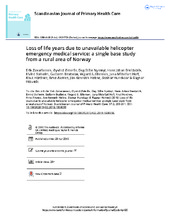Loss of life years due to unavailable helicopter emergency medical service: a single base study from a rural area of Norway
Zakariassen, Erik; Østerås, Øyvind; Nystøyl, Dag Ståle; Breidablik, Hans Johan; Solheim, Eivind; Brattebø, Guttorm; Ellensen, Vegard Skalstad; Hoff, Jana Midelfart; Hordnes, Knut; Aksnes, Arne; Heltne, Jon-Kenneth; Hunskaar, Steinar; Hotvedt, Ragnar
Peer reviewed, Journal article
Published version

Åpne
Permanent lenke
https://hdl.handle.net/1956/20703Utgivelsesdato
2019Metadata
Vis full innførselSamlinger
Originalversjon
https://doi.org/10.1080/02813432.2019.1608056Sammendrag
Background: Despite the potential benefits of physician-staffed Helicopter Emergency Medical Service (HEMS), many dispatches to primary HEMS missions in Norway are cancelled before patient encounter. Information is sparse regarding the health consequences when medically indicated HEMS missions are cancelled and the patients are treated by a GP and ambulance staff only. We aimed to estimate the potential loss of life years for patients in these situations. Method: We included all HEMS requests in the period 2010–2013 from Sogn and Fjordane County that were medically indicated but subsequently cancelled. This provided a selection of patients, with the purpose of studying cancellations independently of the patient’s medical status A multidisciplinary expert panel retrospectively assessed each patient’s potential loss of life years due to the lack of helicopter transport and intervention by a HEMS physician. Results: The study included 184 patients from 176 missions. Because of unavailable HEMS, seven patients (4%) were anticipated to have lost a total of 18 life years. Three patients suffered from myocardial infarction, three from stroke and one from abdominal haemorrhage. The main contribution from HEMS care in these seven cases might have been rapid transport to definitive care. The probability of a patient losing life years when in need of HEMS evacuation was found to be 0.2%. Conclusion: During the four years period seven patients lost 18 life years. Lack of rapid transport seems to be the primary cause of lost life years in this specific geographical area.
